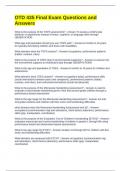OTD 435 Final Exam Questions and
Answers
What is the purpose of the TOPS assessment? - Answer-To assess a child's play
behavior on playfulness instead of motor, cognitive, or language skills through
OBSERVATION
What age and population should you use TOPS with? - Answer-6 months to 18 years
for typically developing children and those with disabilities
What domains does the TOPS assess? - Answer-occupations, performance patterns
(habits, routines, roles)
What is the purpose of TOES (test of environmental supports)? - Answer-to assess how
the environment supports an individual's play through OBSERVATIONS
What is the age and population of TOES - Answer-6 months to 18 years for children and
adolescents
What domains does TOES assess? - Answer-occupations (play), performance skills
(social interactions between peers and caregivers), performance patterns (habits,
routines, and roles), and contexts/environments (social and physcial)
What is the purpose of the Minnesota Handwriting Assessment? - Answer-is used to
evaluate or discriminate handwriting print in first and second grade children through a
performance based assessment
What is the age range for the Minnesota Handwriting Assessment? - Answer-1st and
2nd grade students and children with fine motor and handwriting difficulties
what domains does the Minnesota Handwriting Assessment look at? - Answer-
occupations (communication mgt and education), client factors (attention), performance
skills (girp, manipulates, coordinates)
What is the purpose of the Evaluation Tool of Children's Handwriting (ETCH)? - Answer-
evaluates manuscript and cursive handwriting of children in grades 1 through 6th using
performance based and observation based assessments
What is the age range for ETCH? - Answer-Grades 1st through 6th for children with fine
motor and handwriting difficulties
What domains are assessed with ETCH? - Answer-occupations (communication mgt
and education), client factors (attention), performance skills (grip, manipulates,
coordinates)
, What is the purpose of the Sensory Profile 2 (SP2)? - Answer-to assess the impact of
sensory preferences and sensory processing that may support or hinder participate and
function in daily occupations through questionnaire or observation-based assessment
What is the age range for the sensory profile 2? - Answer-birth to 14 years and 11
month and adults/adolescent form for 11 years and older
(infants, toddlers, children, adolescents, and adults)
What are the domains the sensory profile 2 looks at? - Answer-client factors (emotional
function, experience of self and time, sensory functions) performance skills (touches,
regulates, places self, expresses emotions), and contexts/environments (school, home,
daycare settings, natural environment)
What is the purpose of Sensory Processing Measure 2 (SPM-2) - Answer-Utilizes
reported observations across contexts to measure the client's sensory processing
(visual, auditory, tactile, proprioceptive, vestibular, and olfactory and gustatory), praxis,
and social participation through observer-rated or self-report
What are the age ranges for Sensory processing measure 2 (SMP-2)? - Answer-4
months to 87 years old
What are the domains assessed with sensory processing measure 2 (SPM-2)? -
Answer-client factors (emotion function, experience of self and time, perception,
sensory functions)
performance skills (touches, regulates, places self, expresses emotion,
notices/responds, adjusts, and social interactions)
contexts/environment (home, school, and community environment)
What is the purpose of Structured Observation of Sensory Integration-Motor (SOSI-M) -
Answer-to assess proprioception, vestibular processing, motor planning, and postural
control through observation-based and performance-based assessments
What is the age range for Structured observation of sensory integration-motor (SOSI-
M)? - Answer-ages 5 to 14 years old who have suspected sensory processing
difficulties resulting in motor impairments
What domains are assessed with the structured observation of sensory integration-
motor (SOSI-M) - Answer-Client factors (muscle functions, movement functions,
sensory functions) performance skills (Motor and processing)
What is the purpose of the Goal Oriented Assessment of Lifeskills (GOAL)? - Answer-to
evaluate functional motor skills in activities of daily living of children through
performance-based assessments




